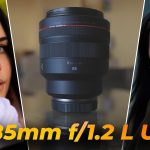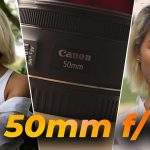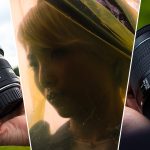
Many new photographers worry about whether the cheaper lenses, which they can actually afford, are really any good. To be fair, it’s easy to look at some of the pricier lenses out there, marvel at their intricate designs, and think that they are they only ones worth owning.
The truth is that there are plenty of affordable lenses out there, which can produce great results, for a budget. In fact, what matters most is who is behind the camera. A skilled photographer or videographer can do really cool things with a cheap lens, as they know how to pull every bit of performance out of them.
Before we go into some affordable lenses, and what they can do, if you want to get better at photography without actually spending any extra money, I’ve published lot of articles about that in this website.
Now, I’m going to show you three affordable lenses, and we’re going to discuss what they’re good for.

Canon EF-S 18-55mm f/3.5-5.6 IS STM
This is basically the Canon kit lens. It can do a little bit of everything, whilst not really excelling at anything in particular.
You can zoom out to 18mm, in order to capture wider shots, like street scenes, or groups of people, and you can zoom it in to 55mm, which is handier for portraits, especially if you’re using a camera body with a cropped sensor.
What do I mean by this?
Most affordable cameras have what is known as a cropped sensor. They’re not full frame, like the Canon R5 for example, but the sensor is smaller instead. This gives a magnifying effect.
Focal Length
So, if you’re zoomed all the way in at 55mm on your lens, in the case of Canon cropped sensor cameras, you have to multiply that number by x1.6, in order to get the true focal length.
In the case of this length, that would be 55mm * 1.6 = 88mm
The focal length of 88mm is close to 85mm, which is considered the most flattering focal length for portraits. It tends to give a more realistic image of what the person looks like, as opposed to photographing them at 18mm, which would distort their face somewhat, especially around the edges.
What most people don’t realise actually, is that this lens is quite nifty for video as well. Since it has image stabilisation, it allows you to film smoother video, and that’s fantastic, especially if you shoot a lot of B-roll, like I do.
In fact, the B-roll of this lens was shot on a Canon 77D, with another 18-55mm kit lens, so if you know what you’re doing, you can get some pretty cool footage.
One of the bigger downside of this lens is that it can only open up to f/3.5 when zoomed all the way out, and f/5.6 when zoomed all the way in. This means that in low light situations, you’ll be able to allow less light into the lens, which will force you to bump up the ISO, and thus potentially get more noise in your footage.
And now, let’s jump to the next lens.

Canon EF 50mm f/1.4 USM
If you remember the formula from earlier, in order to calculate the true focal length of this lens on a cropped sensor body, we have to multiply 50mm by x1.6, which gives us 80mm.
Again, this is close to that ideal 85mm for portraits, and in fact, most people will use this lens specifically for that. Unlike the kit Canon lens, this beauty can open up to f/1.4, which allows in a lot more light, allowing you to get cleaner shots in low light scenarios, and it also allows you to get some pretty cool Bokeh.
The focal length of this lens is also fixed. Unlike the one from earlier, which could be zoomed in from 18mm to 55mm, this one is fixed at 50mm. This can be both a good and a bad thing. It’s obviously bad, as the focal length is not variable, so you cannot change it, but the good news is that fixed lenses tend to produce sharper images.
Image Stabilisation
Now, since this lens can let in more light, you might ask, why did I use to use the 18-55mm kit lens for most of my videography in the past? The reason is because the EF 50mm f/1.4 does not have image stabilisation.
When shooting video, the results would be much shakier. Plus, when you’re shooting B-roll, you want to keep your focal length a bit lower. The higher it is, the more obvious the shake will be.
When I shoot B-roll nowadays, on my Canon R5, with the RF 15-35mm f2.8 L IS USM, I usually shoot between 24mm and 35mm. I obviously can’t shoot any higher than 35mm on this lens, but the higher you get, the more obvious the shake, and I don’t shoot lower than 24mm, as the built-in image stabilisation in the camera can cause some weird distortion to the edges of the frame below 20mm.
Keeping it between 24mm and 35mm ensures that the distortion is not visible, whilst ensuring that any shake that might be present is also not noticeable.
By the way, since the R5 is a full frame camera, no maths is needed. The lens name assumes you’re using a full-frame camera, so the focal length is whatever it says at the top of the lens.
I’ve also reviewed both these lenses on my YouTube channel, so if you’re interested, you can watch them here.

Canon EF 75-300mm f/4-5.6 III
We’ve covered a kit lens with a variable focal length, and a fixed 50mm lens. Now it’s time to cover a tele lens. As you can see from the name of the lens, it can zoom in from 75mm, all the way to 300mm.
If we apply the maths we learned earlier, on a cropped sensor body, this is equivalent to 120mm to 480mm.
In fact, when I was doing a test shoot for this lens, I had to stand comically far away from the model, in order to shoot zoomed all the way in.
By the way, the reason why I keep doing the maths is because I’m assuming you’ll be using these lenses on a cropped sensor body, which is typically more affordable.
Now, a lens like this would typically be used for wildlife, such as photographing birds, or other animals, as it allows you to keep your distance.
I personally quite like it for portraits as well, and I’ve done a couple of photoshoots with this exact lens.
Some people will say that they don’t really like this lens, but given how affordable it is, it is clearly intended as a budget lens, so one can’t have the same expectations from it as they would have from a much more expensive tele lens.
Low Light
One of its issues, is the variable aperture, opening up to only f/4 when zoomed all the way out, and f/5.6 when zoomed all the way in.
If you’re shooting in a low light environment, you might struggle a bit, especially if you’re shooting wildlife, and your shutter speed is set quite fast, in order to freeze movement.
In that scenario, all you could really do is bump up your ISO, which can introduce noise into the image.
Another issue is actually inherent to tele lenses, and that is that it can be tricky to use handheld, even if just doing portraits. When zoomed all the way in, standing far away, you might actually struggle to even get the model in frame. Doing video is also quite challenging, as the footage will inevitably look shaky.
A tripod would obviously solve this problem, but bear in mind that this issue exists.
I’ve also reviewed this lens more in-depth on my YouTube channel, and you can watch it here.

So, in conclusion, when used properly, even budget lenses can achieve some really cool shots.
If you’d like to purchase any of the items I’ve mentioned in this article, or see how much they cost in your country, I have a link down below where you can view them.
Thank you for reading my comparison review between the Canon EF-S 18-55mm vs Canon EF 50mm f1.4 vs Canon EF 75-300mm. I invite you to have a look at some of my other articles. We have something for everyone, whether you’re interested in audio, or cameras and lenses. Alternatively, if you prefer video reviews, feel free to have a look at my YouTube channel.
Product Links
Down below you will find all of the items I talked about in this article.



